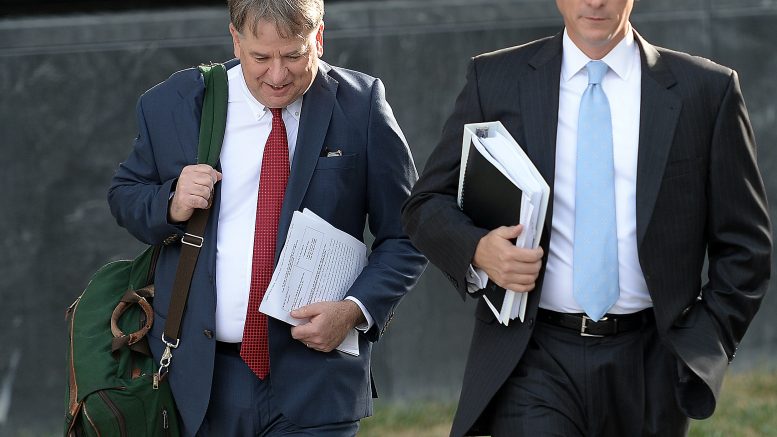Late Monday afternoon, U.S. District Judge John T. Copenhaver made public the “term sheets” in tentative class-action settlements with West Virginia American Water Co . and Eastman Chemical Co . aimed at resolving litigation over the role both companies played in the water crisis that followed the Jan. 9, 2014, chemical spill at Freedom Industries.
The settlements are far from final, and there are many steps left to go before residents, businesses and workers will see any compensation. Here’s a look at what we know and what we don’t know at this point:
How much money is involved?
The total settlement amount is up to $151 million. It’s “up to” that amount because at some point, if claims filed by residents and businesses don’t use up all the money, some of it will go back to West Virginia American and Eastman.
Of the total amount in the two settlements, $126 million of it will come from the deal with West Virginia American Water, its parent company, and an affiliated service company. The other $25 million comes from Eastman Chemical. It’s not entirely clear at this point how much of the settlement comes from insurance policies, but a new lawsuit filed by West Virginia American against one of its insurers suggests some of the water company’s insurers are paying, but at least one of them had as of Friday been balking at providing coverage for the settlement.
What is the settlement about?
The central lawsuit that prompted the settlement is called Crystal Good v. American Water Works Co , for a local resident who was the lead named plaintiff and for West Virginia American Water’s parent company. It was set for a trial to start on Oct. 25 , in which the focus was not so much what caused the Freedom Industries spill, but what caused the spill to be allowed to contaminate the region’s drinking water supply.
While West Virginia American Water and Eastman in their defense wanted to point to Freedom’s criminal negligence , the plaintiffs planned to present a detailed case about the water company and Eastman.
For example, the plaintiffs planned to present evidence that West Virginia American was treating and storing drinking water at far below its capacity in the cold days prior to the spill, leaving it with little in the way of backup water that would have allowed it to briefly close the Elk River intake until the worst of the spill had passed. Plaintiffs alleged that the water company, by allowing the drinking water to be contaminated, had breached its contract with its customers across the region. The plaintiffs alleged that Eastman didn’t warn Freedom Industries that the Crude MCHM Eastman sold could corrode Freedom’s chemical tanks, and that Eastman officials knew the Freedom site was in terrible disrepair, but did nothing about it.
The trial itself, though, was only going to be about fault — whether the water company and Eastman were liable for the drinking water contamination. Had the plaintiffs gone to trial and won on that issue, any awarding of monetary damages could have taken much longer, through a separate legal proceeding.
Who is covered by the settlement?
The case that was set for trial covered a broad class that included three categories of people: Everyone who lived at the time of the spill in a dwelling supplied with tap water by the West Virginia American Kanawha Valley Treatment Plant, everyone who at that time owned a business supplied with water by that plant, and everyone who worked at a business supplied with water from the plant, but who lived in a dwelling that got its tap water from some other source. Expert testimony in the pre-trial phase of the case put the size of the resident class at about 224,000 people and the business owner class at more than 7,300 people. It is not clear how many wage earners could be covered.
The water company settlement’s term sheet , though, states that a final agreement — still to be prepared by the lawyers for both sides — “will identify a proposed settlement class” that would have to be approved by the court.
What if I didn’t sign up for any lawsuits?
Generally speaking, class actions don’t work that way. Anyone who fits into the class definition that is eventually approved by the court as the “proposed settlement class” would automatically be part of the case. The intent of the settlement is to resolve all litigation over the water crisis with Eastman and West Virginia American. This includes not just the “Good” case that was set for trial, but a variety of other cases that were pending in state and federal courts.
At least one case has already been identified as not being part of the settlement, one brought on behalf of the West Virginia Hospitality Association. People who fall within the definition of the class will also have an opportunity later to “opt-out” of the settlement. But the term sheets also indicate that, if enough people do that, the defendants can decide to pull out of the deal. For example, if more than 1,100 claimants opt-out of the Eastman settlement, Eastman can terminate its obligation to pay. West Virginia American can back out of the deal if either 900 individuals or 250 businesses opt-out of the settlement.
Photo by F. Brian Ferguson / West Virginia American Water lawyers Tom Hurney, left, and Shawn Bunting, enter the federal courthouse in Charleston
What do the settlements cover?
Lawyers in the case say that the money is intended to compensate residents, businesses and workers for a variety of losses caused by the drinking water contamination, during the up to week-long period that parts of the region were under a “do not use” order to use tap water only for flushing toilets or fighting fires. For example, some residents bought large quantities of bottled water. Others may have relocated for part of the time to a hotel outside the “do not use” area. Some residents sought medical attention after being exposed to the chemicals. Many businesses that rely on water — restaurants, for example — had to close. Workers at those establishments didn’t get paid.
The Eastman Chemical term sheet says that the $25 million in that part of the deal is for payments “limited to damages arising from physical harm to person or property.” Prior to trial, Eastman had argued that it could not be forced by a jury to pay purely “economic losses,” or monetary losses in the absence of physical harm to person or property. But Copenhaver ruled that contamination of one’s tap water could be considered physical damage to property, allowing such claims if there had been a trial. The language also means that a business that had to shut its doors has a claim for lost profits, because the physical invasion of their water triggers that ability to claim business losses.
The settlement also allows compensation for “wager earners,” even though Copenhaver had thrown out those claims against West Virginia American had there been a trial.
How will this all work?
That’s not entirely clear yet.
Both settlements refer to an administrator who would manage the processing of claims and distribution of funds. The West Virginia American term sheet refers to payment of claims being made “though an agreed upon claims process to be administered by an agreed-upon administrator. The parties are also to agree to a process for notifying the class members and attempting to “maximize participation” in the settlement process.
The water company term sheet describes two different funds of money: A “guaranteed fund” and a “claims-based payment” fund.
Under the deal, West Virginia American will pay $76 million into the guaranteed fund. This will fund direct payments to residential and business class members upon “satisfactory proof” that as of Jan. 9, 2014, the class member was a residential or business customer of West Virginia American Water and served by the Kanawha Valley Treatment Plant. Each qualifying residential or business class member can receive a “single uniform payment” in an amount that the parties have yet to negotiate. The water company term sheet says that the parties intend for the $76 million from West Virginia American and the $25 million from Eastman to be “considered together” for purposes of making these direct payments to class members.
West Virginia American will pay $50 million for “claims-based payments” to class members. These are for class members who do not want to accept the standard payments from the guaranteed fund and want to provide “appropriate objective documentation” of other — presumably larger — losses. The parties still need to negotiate the criteria for the settlement administrator to use in deciding on these sorts of claims. The claims-based payments can go to residents, businesses, and this is also the portion of the settlement that would cover wage earners, who would also have to provide documentation of their lost wages.
What about the lawyers?
Yes. The lawyers will get paid. It’s not clear how much. One attorney in the case estimated that the plaintiff class lawyers have spent more than $1 million preparing to go to trial. Legal fees and costs for the plaintiff attorneys will come out of the $151 million settlement amount — but the lawyers must petition Copenhaver and receive court approval for the amounts before they are paid. Defense lawyers also are being paid, presumably on an hourly basis by Eastman and the water company.
What happened to Freedom Industries?
Freedom Industries, the corporate entity, was not sued in the federal court case that was set for trial, a move that allowed the case to move forward much more quickly, while other lawsuits over the spill that did name Freedom were delayed by an automatic stay of litigation while Freedom was in bankruptcy court. Two top Freedom Industries officials, Gary Southern and Dennis Farrell, were named in the case. But Southern and Farrell settled with the plaintiffs. They paid a total of $400,000 that was to be paid into a court account, and then used only “to benefit the class.” It’s not yet clear how that money will be used, and Copenhaver hasn’t formally approved that settlement. Southern and Farrell also gave up their claims to any of Freedom’s insurance money, a move that freed up $3 million in insurance money to help clean up the company’s former Etowah River Terminal where the spill occurred.
What happens next?
Attorneys for all sides will expand their “term sheet” documents into actual, formal settlement documents that will be much longer, more complicated, and more detailed. Copenhaver has ordered the parties back to another closed-door meeting with him on Nov. 14 to check on the progress on that. The judge is pushing for quick action on these matters, in part by continuing jury selection in the case until Dec. 5, rather than simply dismissing that process.
Once an actual settlement document is put together, the process of settlement a federal court class-action case is governed by Rule 23(e) of the Federal Rules of Civil Procedure . Notice must be given “in a reasonable manner” to all class members, and the court can approve the settlement only “after a hearing and on finding that it is fair, reasonable, and adequate.” Class members must have an opportunity to request to be excluded from the terms of the deal.
At this point, class members don’t need to do anything to either be included or excluded or to file claims. They should just watch for the public notice.
Is this the end of proceedings about the water crisis?
No. An investigation by the state Public Service Commission continues, though a date for formal hearings has not been set.
Source: blogs.wvgazettemail.com




